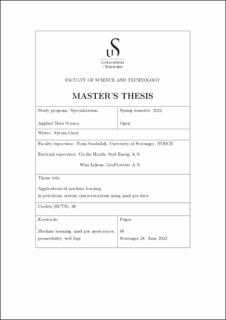| dc.description.abstract | Mud gas data are continuous measurements of the different compounds of the gas released from the formation while drilling. While these data are cheap and extensive, as they are always recorded for safety reasons, they are mainly used qualitatively for fluid and reservoir characterization. It is only recently that mud gas data starts to be used quantitatively. The limited use of mud gas data is generally attributed to the difficulty in making a direct relation to reservoir and fluid properties.
The motivation of this study is to assess the potential use of mud gas data for quicker, better, and more cost-effective assessment of fluid and reservoir properties which would be beneficial for both exploration and development. Potentially, this could allow for better understanding of the reservoir, better development strategies, identifying missed net pay leading to new exploration and development opportunities, decrease data acquisition costs and more …
In this master project, 40 wells in quad 35 of the Norwegian sector of Northern North Sea, were investigated using data analytics to explore the mud gas data and relate it to reservoir properties by evaluating model outputs and how they relate to real physical behavior. We focused on three predictive tasks (two classifications and one regression):
1) Identifying hydrocarbon bearing zones in the reservoir rock through supervised classification using features from mud gas data
2) Identifying fluid type (Gas or Oil) in hydrocarbon bearing zones through supervised classification using features from mud gas data
3) Estimating permeability in hydrocarbon bearing zones from combining mud gas data with logging data through supervised prediction
\end{enumerate}
First, data were exported from different sources and loaded to R and Jupyter Notebook. The data were resampled in accordance with mud data resolution. Some of the features were then log transformed and scaled to reduce skewness and improve prediction capability. Then, Multiple machine learning models (Linear with subset selection, Lasso, Ridge, Random Forest, Boosting, SVM and Neural Network) were generated and compared. For each model, hyperparameters were tuned either based on validation set or cross validation. Then, a more realistic approach was developed to test the different models by leave one well out cross validation (LOWOCV), which is less sensitive to systematic error from sampling and experience bias, to rank the different models. For the first and second classification tasks a separate well was also used as a test set.
The first classification results (distinguishing water from hydrocarbon) provided a moderately good prediction. The training set for this task consists of 2952 samples and 281 for the test set. Most of the models provided comparable results. The best model ‘logistic regression with features selection’ had a LOWOCV AUC=0.82, F1score=0.55, accuracy=0.77. The same model was the best for the test set with AUC=0.87, F1score=0.82, accuracy=0.96. The modest performance for distinguishing water from hydrocarbon using mud gas data is probably due to the presence of low saturation gas in some sand intervals.
The second classification showed much better results and allowed for a very good performance with regards to distinguishing gas and oil. The training set consists of 611 samples and 102 for the test set. The best model ‘logistic regression with features selection’ had a LOWOCV AUC=0.86, F1score=0.87 and accuracy=0.84, and a test set AUC=0.99, F1score=0.94 and accuracy=0.93. The main features important for the prediction are the different gas ratios which is in alignment with the finding of Pixler in 1969 \cite{Pixler}.
The third prediction had a sample size of 282 observations and showed that adding mud gas data to porosity and shale volume improved the prediction of permeability compared to conventional approach of using only porosity or porosity with shale volume. The best model was linear regression with subset selection and R2 of the LOWOCV had improved from 0.65 to 0.85 by adding mud gas features as C1, and C1/(DEPTH*MW). Physically, C1/(DEPTH*MW) or (C1/MW) could be considered as a gas rate corrected by the mud weight or depth*mud weight. However, for this task the sample size is small making the generalization of this finding difficult.
The results of these different models for the three tasks, were loaded to Petrel software to allow better use and visualization by geoscientists.
While the data set is limited, we succeeded in obtaining valuable results from mud gas data which could be a base for further work and investigations. | |
